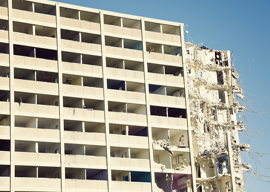
February 28, 2018

Demolition of Cabrini Green
Source: Bigstock
To see how much better things can be, consider the Dow Jones average. It closed on Dec. 31, 1981, at 875. That wasn’t very high, but then again, it could be worse, right? After all, the Dow had never gotten much over 1,000.
Last Friday, it closed at 25,709. Some of that rise is due to inflation, but much of it is due to the Milken Era philosophy of maximizing shareholder wealth.
Similarly, the total net worth of the Forbes 400 in 1982 was $218 billion, or about $550 billion in current dollars. Those guys seemed to be doing really well in 1982, but the 2017 Forbes 400 were worth $2.7 trillion.
Why? In part because rich guys wanted to get even richer, and made sure that they did.
Why shouldn’t Americans as a whole want to live better too?
My second reason is: Why should the bad guys get to win by lying? (If they’re not the bad guys, then why do they lie so much?)
Consider a real estate anecdote that turned out to presage the entire Obama Era.
In 1988 my wife and I were standing on North Avenue in Chicago, holding the real estate section of the Chicago Tribune. A well-dressed white guy, a real estate developer, walked up to us and started pitching us on why we should buy a condo in this up-and-coming neighborhood, only two miles from the Loop.
I pointed to the looming towers of Cabrini-Green, the most notorious public housing project in America. He responded that Cabrini-Green was going to be demolished. It was practically a done deal: The real estate it was sitting on, only a mile from Michigan Avenue’s Magnificent Mile, was too valuable to devote to losers.
I asked: “Which alderman is going to welcome Cabrini-Green’s 13,000 welfare moms and their drug dealer boyfriends into his ward?” He didn’t have an answer to that question, which has since turned out to be one of the central conundrums of 21st-century American politics, as the people who went on to tear down Cabrini-Green took over the White House under Barack Obama.
In 1989, Richard M. Daley was elected mayor of Chicago. Assisted by his brother William M. Daley, current mayor Rahm Emanuel, David Axelrod, and Valerie Jarrett (Obama’s first two chiefs of staff, his campaign strategist, and his personal consigliere), Daley managed to tear down Cabrini-Green by 2011, vastly boosting real estate values on the Near North Side.
But what to do with the ex-residents of the demolished housing projects?
The Chicago insiders who ruled America in 2009–2017 could never quite agree on whether to send them to the far edges of Chicago where they could continue to vote Democratic, but with their horrific impact on Chicago’s homicide rate, or to use Section 8 to dump them on the suburbs and distant cities. The Obama Administration helpfully sued Dubuque, Iowa, for not being as welcoming to ex-Cabrini residents as the Gold Coast real estate barons wished.
The one thing the Obama insiders—politicians, billionaires like Penny Pritzker, and their lackeys in the press—could agree upon was that American citizens should not be allowed to discuss their plans to ethnically cleanse blacks from central Chicago. Somebody might get the wrong idea that the Chicago elites didn’t have the American public’s best interests at heart.
In contrast, my view is that that the central ethical principle of politics ought to be open argument: Everybody should be allowed to have his honest say. If the billionaires of Chicago want to get even richer by dispatching their troublesome African-Americans to Dubuque, then let them state their reasons in the public square.
And the voters of Dubuque should be able to answer back without being shamed or sued by the powerful.